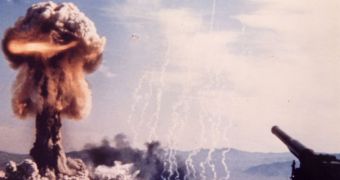The Cold War was a time when all kinds of dangerous weapons were built, just to prove that one country could do it before the other. The nuclear bomb recently discovered, it soon became the ultimate terror weapon and a constant threat that the entire planet was forced to live with for decades.
It wasn't long after the development of the first atomic bombs, that the USA and the USSR began investigating how these terrible weapons could be used tactically. This meant incorporating them into conventional weapons systems, thus combining the best in both technologies.
Among these interpretations of nuclear war was the atomic canon a project that lasted until 1991, when the two superpowers first agreed to withdraw their nuclear artillery shells from service.
The US version of the atomic cannon was first tested on May 25, 1953 at the Nevada Test Site and was known as Operation Upshot-Knothole, codenamed Shot GRABLE. This was a modified artillery shell, 280 mm (11 in) wide, carrying a nuclear fission warhead, that could be launched by a loosely modified cannon.
The first and only nuclear artillery shell to be tested in the entire program, fortunately, was launched by an artillery gun dubbed "Atomic Annie," at a distance of 10,000 meters (6.2 mi) and detonated at 160 m (525 feet) above ground.
The estimated yield of the explosion was of 15 kilotons, meaning it had the equivalent in explosive force to 15,000 tons of TNT. That is also the official yield estimate of "Little Boy," the atomic bomb which was dropped on Hiroshima, on August 6, 1945.
Only 20 of the 1384 mm (4.5 ft) long shells, weighing 365 kg (805 lb) were ever produced and none was used in real combat situations. Further development of the nuclear shell eventually led to a 40 kilotons warhead that was abandoned at the end of the 1970s and from 2003, the focus moved towards nuclear bunker buster projectiles.
Although an evolutionary dead end, this project shows to what degree nuclear paranoia could be pushed by two countries that wanted to show off at any cost, one that fooled its citizens in believing that they would be safely shielded from a global thermonuclear war in a homemade bunker under the front lawn and the other which didn't even bother to protect its citizens, counting on the huge land area for the survival of the great nation.

 14 DAY TRIAL //
14 DAY TRIAL //